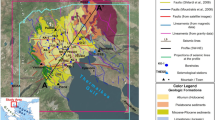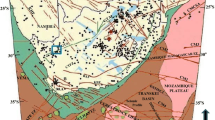Abstract
We analyzed 2-D seismic and well-log data from the southern Jeju Basin, offshore southern Korea, northern East China Sea to estimate the CO2 storage capacity of the structural traps in the area. Sand intervals with >10-m gross thickness were identified from the gamma-ray logs and their porosity was estimated from the neutron logs corrected for the shale effect. A total of 14 structural closures was delineated from the depth-converted maps of the sand intervals. Seismic inversion and multi-attribute transform were performed to predict the reservoir quality (i.e., porosity) of the closures away from the well control. The total storage capacity of the closures was estimated from the deterministic, volumetric method, based on the published storage efficiency parameters. The estimated CO2 storage capacity for the 14 closures is about 302 Mt, comparable to the CO2 emission (ca. 530 Mt) of Korea in 2009.
Similar content being viewed by others
References
Asquith, G. and Krygowski, D., 2004, Basic Well Log Analysis (2nd Edition). American Association of Petroleum Geologists Methods in Exploration Series, No. 16, 244 p.
Bachu, S., 2003, Screening and ranking sedimentary basins for sequestration of CO2 in geological media in response to climate change. Environmental Geology, 44, 277–289.
Bachu, S., Bonijoly, D., Bradshaw, J., Burruss, R., Holloway, S., Christensen, N.P., and Mathiassen, O.M., 2007, CO2 storage capacity estimation: Methodology and gaps. International Journal of Greenhouse Gas Control, 1, 430–443.
Birkholzer, J.T., Zhou, Q., and Tsang, C.-F., 2009, Large-scale impact of CO2 storage in deep saline aquifer: A sensitivity study on pressure response in stratified systems. International Journal of Greenhouse Gas Control, 3, 181–194.
CSLF (Carbon Sequestration Leadership Forum), 2007, Estimation of CO2 Storage Capacity in Geological Media — Phase II Report, 43 p.
Dewan, J., 1983, Essentials of Modern Open-Hole Log Interpretation. PennWell Publishing Company, Tulsa, Oklahoma, 361 p.
EERC (Energy & Environmental Research Center), 2009, Development of Storage Coefficients for Carbon Dioxide Storage in Deep Saline Formations. 94 p.
Energy Information Administration, International Energy Statistics, Total Carbon Dioxide Emissions from the Consumption of Energy, 〈http://www.eia.gov/cfapps/ipdbproject/IEDIndex3.cfm?tid=90&pid=44&aid=8〉 Accessed November, 2011.
Gungor, A., Lee, G.H., Kim, H.J., Han, H.C., Kang, M.H., Kim, J., and Sunwoo, D., 2012, Structural characteristics of the northern Okinawa Trough and adjacent areas from regional seismic reflection data: geologic and tectonic implications. Tectonophysics, 522–523, 198–207.
Jahn, F., Cook, M., and Graham, M., 2008, Hydrocarbon Exploration and Production (2nd Edition). Elsevier, Developments in Petroleum Science 55, 444 p.
Hampson, D.P., Schulke, J.S., and Quirein, J.A., 2001, Use of multiattribute transforms to predict log properties from seismic data. Geophysics, 66, 220–236.
Helander, D.P., 1983, Fundamentals of Formation Evaluation. Tulsa, Oklahoma, OGCI Publications, 332 p.
Hitchon, B., 1996, Aquifer Disposal of Carbon Dioxide: Hydrodynamic and Mineral Trapping — Proof of Concept. Geoscience Publishing Ltd., Sherwood Park, Alberta, Canada, 165 p.
IPCC (Intergovernmental Panel on Climate Change), 2005, IPCC Special Report on Carbon Dioxide Capture and Storage. Cambridge University Press, 431 p.
KIGAM (Korea Institute of Geoscience and Mineral Resources), 1997, Hydrocarbon potential of the northern East China Shelf Basin I: Korea Institute of Geoscience and Mineral Resources (KIGAM) Report, not paginated.
Kim, Y., Lee, K., Jo, S., Kim, M., Kim, J.-S., and Park, M.h., 2012, A preliminary evaluation on CO2 storage capacity of the southwestern part of Ulleung Basin, offshore, East Sea. Economic and Environmental Geology, 45, 41–48.
Kopp, A., Class, H., and Helmig, R., 2009, Investigation on CO2 storage capacity in saline aquifers Part 1. Dimensional analysis of flow processes and reservoir characteristics. International Journal of Greenhouse Gas Control, 3, 263–276.
Kwon, Y.-I. and Boggs Jr., S., 2002, Provenance interpretation of Tertiary sandstones from the Cheju Basin (NE East China Sea): a comparison of conventional petrolographic and scanning cathodoluminescence techniques. Sedimentary Geology, 152, 29–43.
Lee, G.H., Kim, H.J., Han, S.J., and Kim, D.C., 2001, Seismic stratigraphy of the deep Ulleung Basin in the East Sea (Japan Sea) back-arc basin. Marine and Petroleum Geology, 18, 615–634.
Lee, G.H., Kim, B., Shin, K.S., and Sunwoo, D., 2006, Geologic evolution and aspects of the petroleum geology of the northern East China Sea shelf basin. American Association of Petroleum Geologists Bulletin, 90, 237–260.
NETL (National Energy Technology Laboratory), 2010, Carbon Sequestration Atlas of the United States and Canada (Third Edition), 162 p.
Russell, B., Hampson, D., Schuelke, J., and Quirein, J., 1997, Multiattribute seismic analysis. The Leading Edge, 16, 1439–1443.
Schlumberger, 1989, Log Interpretation Principles/Applications. Schlumberger Education Services, Houston, 223 p.
Schultz, P.S., Ronen, S., Hattori, M., and Corbett, C., 1994, Seismicguided estimation of log properties, Part 1. The Leading Edge, 13, 305–310, 315.
Shinn, Y.J., Chough, S.K., and Hwang, I.G., 2009, Structural development and tectonic evolution of Gunsan Basin (Cretaceous-Tertiary) in the central Yellow Sea. Marine and Petroleum Geology, 27, 500–514.
Span, R. and Wagner, W., 1996, A new equation of state for carbon dioxide covering the fluid region from the triple-point temperature to 1100 K at pressures up to 800 MPa. Journal of Physical Chemistry Data, 25, 1509–1596.
Van der Meer, B. and Egberts, P., 2008, Calculating subsurface CO2 storage capacities. The Leading Edge, 27, 520–505.
Weast, R.C., 1967–1968, Handbook of Chemistry and Physics, 48th Edition, CRC Press, Cleveland, Ohio, F–3.
White, C.M., Strazisa, B.R., Granite, E.J., Hoffman, J.S., and Pennline, H.W., 2003, Separation and capture of CO2 from large stationary sources and sequestration in geological formations — coalbeds and deep saline aquifers. Journal of Air and Waste Management Association, 53, 645–715.
Yanagi, T., Shimizu, T., and Matsuno, T., 1996, Baroclinic eddies south of Cheju Island in the East China Sea. Journal of Oceanography, 52, 763–769.
Yang, Q.L., 1992. Geotectonic framework of the East China Sea. In: Watkins, J.S. Zhiqinag, F., and McMillen, K.J. (eds.), Geology and geophysics of continental margins. AAPG Memoir, 53, p. 17–25.
Xu, W., Jiao, R., Deyu, Z., Le, J., and Huang, Z., 1997, Geophysical research of deep tectonics and basin evolution in the East China Sea. In: Liu, B., and Li., S. (eds.), Proceedings of the 30th International Geological Congress Vol. 8: Basin Analysis, Global Sedimentary Geology and Sedimentology. VSP BV, Netherlands, p. 320–331.
Zhou, Z., Zhao, J., and Yin, P., 1989, Characteristics and tectonic evolution of the East China Sea. In: Zhu, X. (ed.), Chinese Sedimentary Basins: Sedimentary Basins of the World 1, Elsevier, p. 165–179.
Author information
Authors and Affiliations
Corresponding author
Rights and permissions
About this article
Cite this article
Lee, G.H., Lee, B., Yi, BY. et al. Estimation of the CO2 storage capacity of the structural traps in the southern Jeju Basin, offshore southern Korea, northern East China Sea. Geosci J 16, 313–326 (2012). https://doi.org/10.1007/s12303-012-0026-3
Received:
Accepted:
Published:
Issue Date:
DOI: https://doi.org/10.1007/s12303-012-0026-3




